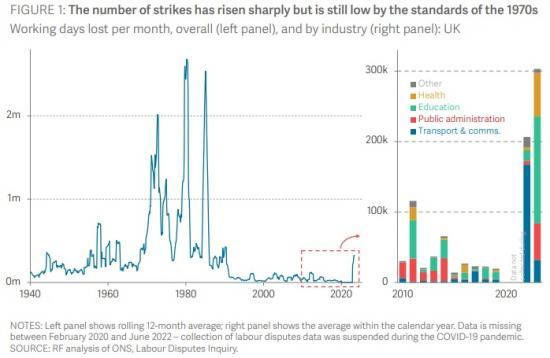Labour Market Outlook Q2 2023
15th August 2023

The UK has seen more strikes in the past year than in any since the 1980s. These strikes have been concentrated in the public and transport sectors, where unionisation rates are highest. The public and public-funded sectors have seen a bigger pay hit than the private sector overall, but there are exceptions - highly unionised transport workers have seen no average real pay hit but lots of strikes, whereas un-unionised personal service workers haven't gone on strike but have seen big pay cuts. Meanwhile, vacancies have increased more in the public sector. In the long run, the need to staff the public sector will push the Government to limit or redress some of the relative pay cuts in coming years.
In our Lifting the Lid section, we compare the employment rates of particular groups during the pandemic and the financial crisis. The data show that part-time workers and workers without degrees fared especially badly in the pandemic, which also hit different regions much more unequally.
Public sector pay
Last month, in line with the recommendations of the public sector pay review bodies, the Government announced pay rises in 2023-24 of between 5 and 7 per cent for several groups of public sector workers. Teachers' unions accepted their 6.5 per cent offer, but the 6 per cent offered to junior doctors was rejected by the British Medical Association, who plan to go ahead with four days of strike action this month. In this article we dig a bit deeper into why the issue of public sector pay has become such a vexed issue.
There has been lots of industrial action in the last two years
The past two years have seen a level of industrial action in the UK not seen since the 1980s. In the 12 months to May 2023, 3.9 million working days were lost to strikes (compared to an average of 450,000 per year during the 2010s), more than at any point since 1989. This 2023 high point is remarkable given the decline in union membership which has taken place over the past few decades - only 22 per cent of employees were in a union in 2022, down significantly from 39 per cent in 1989.
As always, it's useful to have some historical context. Winding the clock further back shows that the level of industrial action in the 1970s was much higher than it is today; in some years, the number of days lost to strikes was more than eight times higher than has been the case over the past year (and this at a time when the size of the workforce was 25 per cent smaller). Data on strike action (including a sector breakdown post-2010 in the right panel) is set out in Figure 1.
Read the full report HERE
12 Pages
